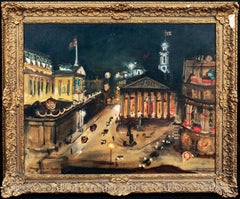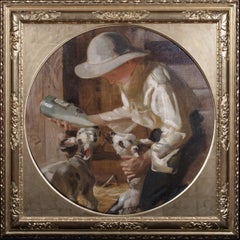Frank Owen Salisbury On Sale
Recent Sales
19th Century Landscape Paintings
Canvas, Oil
19th Century Portrait Paintings
Canvas, Oil
Frank Owen Salisbury for sale on 1stDibs
Frank Owen Salisbury was an English artist who specialized in portraits, large canvases of historical and ceremonial events, stained glass and book illustration. In his heyday, Salisbury was valued and admired on both sides of the Atlantic. In 1901, Salisbury married Alice Maude with whom he had twin daughters. His first Royal Academy exhibit was a portrait of Alice. It is for portraiture that Salisbury is best known. His speed in producing portraits stemmed from his painting his twin daughters every morning for an hour and his career began with child portraiture and his painting the Hertfordshire gentry and members of the Harpenden Methodist Church. Salisbury had a studio at his home, Sarum Chase. A providential meeting with Lord Wakefield, founder of Castrol Oils and a Methodist philanthropist, saw his introduction to society portraiture. Salisbury's being selected to paint the Boy Cornwell in the Battle of Jutland then brought him to the notice of Royalty. Lord Wakefield then arranged for him to paint President Woodrow Wilson whilst he was in London, but Wilson departed for Paris and the opportunity was lost. It was to be John W. Davis, American Ambassador to London, who encouraged Salisbury to go to the USA; Davis had met Salisbury at art receptions and had admired his child portraits. 25 members of the Royal House of Windsor sat for Salisbury and he was the first artist to paint HM Queen Elizabeth II. Salisbury painted Winston Churchill on more occasions than any other artist; the two iconic images of Churchill - The Siren Suit and Blood, Sweat and Tears are both Salisbury images. Other significant portraits include those of Richard Burton, Andrew Carnegie, Sir Alan Cobham, Sir Robert Ludwig Mond, Maria Montessori, Montgomery of Alamein, Earl Mountbatten of Burma, Benito Mussolini, John Player, Lord Rank, Jan-Christiaan Smuts and Sir Henry Wood. Salisbury was remarkably successful in the USA where he was deemed to have fulfilled the American Dream. Salisbury made 13 visits and painted six Presidents with his Franklin D. Roosevelt remaining as the official White House portrait to this day. Industrial and financial giants who sat for him included Henry Clay Folger, Elbert Henry Gary, Edward Stephen Harkness, Will Keith Kellogg, Andrew William Mellon, John Pierpont Morgan, George Mortimer Pullman, John Davison Rockefeller Jr. and Myron C. Taylor.
Finding the Right paintings for You
Painting is an art form that has spanned innumerable cultures, with artists using the medium to tell stories, explore and communicate ideas and express themselves. To bring abstract, landscape and still-life paintings into your home is to celebrate and share in the long tradition of this discipline.
When we look at paintings, particularly those that originated in the past, we learn about history, other cultures and countries of the world. Like every other work of art, paintings — whether they are contemporary creations or works that were made during the 19th century — can often help us clearly see and understand the world around us in a meaningful and interesting way.
Cave walls were the canvases for what were arguably the world’s first landscape paintings, which depict natural scenery through art. Portrait paintings and drawings, which, along with sculpture, were how someone’s appearance was recorded prior to the advent of photography, are at least as old as Ancient Egypt. In the Netherlands, landscapes were a major theme for painters as early as the 1500s. Later, artists in Greece, Rome and elsewhere created vast wall paintings to decorate stately homes, churches and tombs. Today, creating a wall of art is a wonderful way to enhance your space, showcase beautiful pieces and tie an interior design together.
No matter your preference, whether you favor Post-Impressionist paintings, animal paintings, Surrealism, Pop art or another movement or specific period, arranging art on a blank wall allows you to evoke emotions in a room while also showing off your tastes and interests. A symmetrical wall arrangement may comprise a grid of four to six pieces or, for an odd number of works, a horizontal row. Asymmetrical arrangements, which may be small clusters of art or large, salon-style gallery walls, have a more collected and eclectic feel. Download the 1stDibs app, which includes a handy “View on Wall” feature that allows you to see how a particular artwork will look on a particular wall, and read about how to arrange wall art. And if you’re searching for the perfect palette for your interior design project, what better place to turn than to the art world’s masters of color?
On 1stDibs, you’ll find an expansive collection of paintings and other fine art for your home or office. Browse abstract paintings, portrait paintings, paintings by popular artists and more today.

